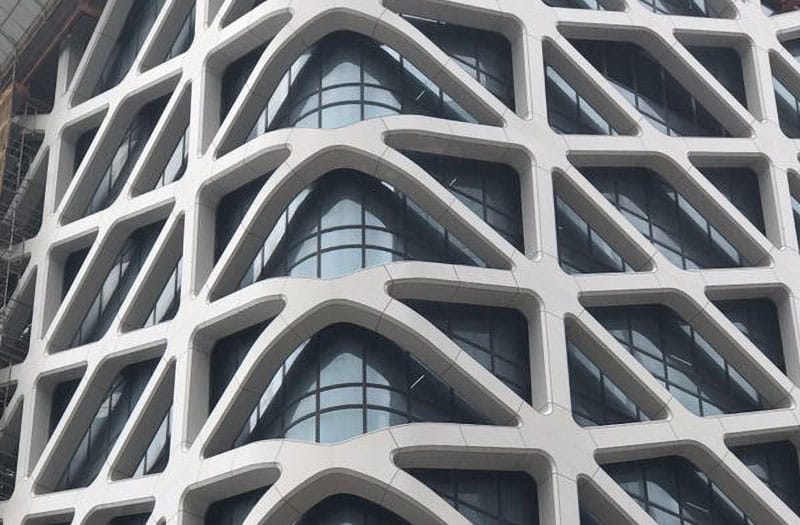In contemporary architectural design, curtain wall, as an important part of the building’s external protective structure, not only bears the function of protecting the main body of the building, but also is the core carrier of architectural aesthetic expression. As the two mainstream curtain wall forms in the current market, glass curtain wall and aluminum veneer curtain wall each have their own unique performance advantages and applicable scenarios. Today, Middle East Curtain Wall will conduct a comparative analysis from the dimensions of material properties, design performance, construction maintenance, economic cost, environmental protection performance, etc., to provide a reference for architectural design and engineering selection.
1. Comparison of material properties of glass curtain wall and aluminum veneer curtain wall
1.1 Core advantages of glass curtain wall
– Excellent optical performance
The transmittance of ultra-white glass can reach more than 91%, and Low-E insulating glass can selectively transmit visible light and block infrared rays, reducing energy consumption while ensuring natural lighting. For example, the three-silver Low-E insulating glass used in Beijing China Zun can reduce air conditioning energy consumption by 30% in summer.
Controllable thermal performance
Through interlayer inflation, vacuum glass and other technologies, the heat transfer coefficient can be controlled within 0.8W/(m²·K), and a complete insulation system can be formed with thermal insulation profiles. The double-layer curtain wall system of the Shanghai Tower achieves high efficiency and energy saving.
Structural innovation potential
The combination of ultra-clear glass, tempered glass and laminated glass breaks through the traditional size limitations. The maximum size of the curtain wall unit of the Burj Khalifa in Dubai is 4.5m×12m, showing the structural possibilities of glass curtain walls.
1.2 Material advantages of aluminum veneer curtain walls
Significant lightweight characteristics
The density of aluminum alloy is only 1/3 of that of steel, and the surface density of 3mm thick aluminum veneer is about 8kg/m², which reduces the load by 40%-60% compared with glass curtain walls, and is particularly suitable for earthquake-resistant design of high-rise buildings.
Excellent weather resistance
The fluorocarbon coating can withstand salt spray test for more than 3,000 hours. It can be used in coastal high-humidity areas (such as Shenzhen Ping An Financial Center) for 20 years without obvious fading, and the maintenance cycle is 2-3 times longer than glass.
Flexible processing and molding
Complex shapes such as single and double curves can be achieved. The special-shaped aluminum curtain wall used by Guangzhou Grand Theater has a minimum bending radius of 50mm, which meets the needs of non-linear architectural design.
2. Design performance differences
2.1 Contrast of glass curtain wall aesthetics
The visual tension of glass curtain wall
The full-glass curtain wall creates a sense of transparency and light and shadow changes, making it the first choice for urban landmarks. The prism-shaped glass curtain wall of the World Trade Center transportation hub in New York forms a unique spatial experience through light refraction.
Texture performance of aluminum veneer curtain wall
Anodizing, imitation stone grain, perforation and other processes can create rich facade effects. The “Lotus Bowl” of Hangzhou Olympic Sports Center uses a gradient perforated aluminum plate with a hole diameter transition from 8mm to 50mm to achieve a dynamic visual effect.
2.2 Difference in design freedom
Glass curtain walls are limited by their flat characteristics, and curved surface modeling requires expensive hot bending technology (cost increases by about 200%). However, aluminum veneers can easily achieve double-curved surface modeling through CNC bending, and the construction error can be controlled within ±1mm.
3. Economic Analysis of Construction and Maintenance
3.1 Construction Cost Comparison
| Project | Glass Curtain Wall (Yuan/m²) | Aluminum Veneer Curtain Wall (Yuan/m²) |
|—————|——————|——————–|
| Material Cost | 800-1500 | 400-800 |
| Installation Cost | 600-1000 | 300-600 |
| Auxiliary System Cost | 200-400 | 100-200 |
| Total | 1600-2900 | 800-1600 |
3.2 Life Cycle Cost
– The sealant of the glass curtain wall needs to be replaced every 10-15 years, and the maintenance cost accounts for about 20% of the initial cost;
– The maintenance period of the aluminum veneer curtain wall can reach 15-20 years, and the main cost comes from surface cleaning and local repair, and the maintenance cost accounts for about 10%.
IV. Environmental protection and sustainability assessment
4.1 Energy consumption comparison
The energy consumption of glass curtain wall production is about 60kWh/m² (including tempering, coating and other processes), but the use stage can reduce the energy consumption of building lighting by 20%-40%;
The energy consumption of aluminum veneer production is 150kWh/m² (including electrolytic aluminum), but the recycling rate exceeds 95%, which meets the requirements of circular economy.
4.2 Carbon emission data
– The carbon emission of glass curtain wall in its entire life cycle is about 120kgCO₂/m²;
– The initial carbon emission of aluminum veneer curtain wall is about 200kgCO₂/m², but due to the replacement-free feature within the 50-year use cycle, the total emission can be reduced by 30%.
V. Recommendations for typical application scenarios
5.1 Scenarios where glass curtain walls are preferred
– Super high-rise landmark buildings (such as Shanghai World Financial Center)
– Commercial complexes (such as Beijing Taikoo Li)
– Cultural exhibition buildings (such as China National Grand Theater)
– Office buildings that require natural lighting
5.2 Scenarios where aluminum veneer curtain walls are preferred
– Large-span buildings such as airports and stations (such as Daxing International Airport)
– Industrial plants and logistics centers
– Coastal highly corrosive climate zones


